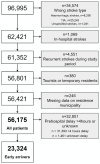Urban-rural inequalities in IV thrombolysis for acute ischemic stroke: A nationwide study
- PMID: 38600682
- PMCID: PMC11418494
- DOI: 10.1177/23969873241244591
Urban-rural inequalities in IV thrombolysis for acute ischemic stroke: A nationwide study
Abstract
Introduction: Rural residency has been associated with lower reperfusion treatment rates for acute ischemic stroke in many countries. We aimed to explore urban-rural differences in IV thrombolysis rates in a small country with universal health care, and short transport times to stroke units.
Patients and methods: In this nationwide cohort study, adult ischemic stroke patients registered in the Danish Stroke Registry (DSR) between 2015 and 2020 were included. The exposure was defined by residence rurality. Data from the DSR, Statistics Denmark, and the Danish Health Data Authority, were linked on the individual level using the Civil Registration Number. Adjusted treatment rates were calculated by balancing baseline characteristics using inverse probability of treatment weights.
Results: Among the included 56,175 patients, prehospital delays were shortest for patients residing in capital municipalities (median 4.7 h), and longest for large town residents (median 7.1 h). Large town residents were predominantly admitted directly to a comprehensive stroke center (98.5%), whereas 30.9% of capital residents were admitted to a hospital with no reperfusion therapy available (non-RT unit). Treatment rates were similar among all non-rural residents (18.5%-18.7%), but slightly lower among rural residents (17.2% [95% CI 16.5-17.8]). After adjusting for age, sex, immigrant status, and educational attainment, rural residents reached treatment rates comparable to capital and large town residents at 18.5% (95% CI 17.7-19.4).
Discussion and conclusion: While treatment rates varied minimally by urban-rural residency, substantial differences in median prehospital delay and admission to non-RT units underscored marked urban-rural differences in potential obstacles to reperfusion therapies.
Keywords: Healthcare disparities; fibrinolytic agents; ischemic stroke; reperfusion; rural population; thrombolytic therapy; urban population.
Conflict of interest statement
Declaration of conflicting interestThe author(s) declared the following potential conflicts of interest with respect to the research, authorship, and/or publication of this article: CS: Supported by research grants from Novo Nordisk Foundation and Health Research Foundation of Central Denmark Region. SB, AB, MS, JN, PC, SJ TP and GA declare no conflict of interest.
Figures





References
-
- Harrington RA, Califf RM, Balamurugan A, et al. Call to action: Rural health: a presidential advisory from the American Heart Association and American Stroke Association. Circulation 2020; 141: e615–e644. - PubMed
-
- Subedi R, Greenberg TL, Roshanafshar S. Does geography matter in mortality? An analysis of potentially avoidable mortality by remoteness index in Canada. Health Rep 2019; 30: 3–15. - PubMed
-
- Hammond G, Luke AA, Elson L, et al. Urban-rural inequities in acute stroke care and In-hospital mortality. Stroke 2020; 51: 2131–2138. - PubMed
-
- Kozera G, Chwojnicki K, Gójska-Grymajło A, et al. Pre-hospital delays and intravenous thrombolysis in urban and rural areas. Acta Neurol Scand 2012; 126: 171–177. - PubMed
MeSH terms
LinkOut - more resources
Full Text Sources
Medical

